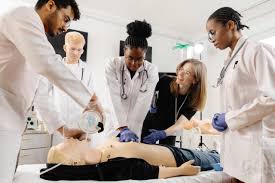If you are a parent, teacher, employee, or business owner, CPR training gives you the ability to help others in an emergency. Cardiopulmonary resuscitation involves manually pumping someone’s chest to help maintain oxygen flow in their body. This procedure is useful in cases such as cardiac arrest, drowning, or choking. Here is the role of cardiopulmonary resuscitation in emergency response:
Restore Regular Blood Circulation
CPR can help a person regain their heartbeat. When the heart stops beating, blood circulation ceases. Before the arrival of medical professionals, you can perform cardiopulmonary resuscitation to support the heart’s function. Organs such as the brain and heart require a constant supply of oxygen-rich blood to function. Compressing your patient’s chest effectively circulates the blood, restoring oxygen levels to these organs. Administering CPR helps in preventing the consequences of oxygen deprivation, like cell death. Effective compressions also help to maintain adequate blood pressure and increase the chances of a successful resuscitation.
Provide Oxygen to the Body
One way to provide oxygen during a cardiac arrest is through rescue breathing. It involves using your mouth or a resuscitation mask to deliver breaths into the patient’s airway, helping to replenish the oxygen supply in their lungs and bloodstream. In emergencies, your actions directly impact the outcome. If you encounter a cardiac arrest patient, check for responsiveness. Prompt recognition of cardiac arrest signs, such as sudden collapse and abnormal breathing, can help you act faster and more confidently. Reputable CPR courses train individuals to observe symptoms of cardiac arrest.
Enroll in CPR training to learn how to assess the airway and breathing and respond effectively. Depending on your training, you may also be able to conduct early defibrillation with an automated external defibrillator for a cardiac arrest patient. This device delivers an electric shock to the heart, which may restart it and restore its normal rhythm. Learn more at nickesfitness.com.
Buy Time During an Emergency
In a cardiac arrest, seconds matter as the heart stops pumping blood to the organs. During this time, the brain and other organs are not getting oxygen and nutrients. By performing CPR, you help maintain blood flow to the brain and other organs until emergency medical personnel arrive.
Calling emergency medical services is a key step in gaining time for the patient. Only move the victim to a safer location if there’s an immediate danger, such as fire or traffic. Otherwise, avoid movement to prevent worsening any potential injuries. Perform CPR continuously, only stopping when medical professionals arrive at the scene.
Stabilize the Patient
During an emergency, CPR is beneficial in helping the body continue to function while waiting for proper medical assistance. When you initiate CPR, you help transport oxygen to organs through the use of chest compressions. You are not addressing the cause of the arrest, but you are assisting in sustaining key body functions temporarily. Acting quickly during the first few minutes of the emergency is necessary to stabilize the patient and prevent further deterioration. If you are performing cardiopulmonary resuscitation for a long period of time, you may want to switch out with another person to avoid fatigue. Working with someone else will also help you maintain a good rhythm.
Invest in Reliable CPR Training
Acquiring cardiopulmonary resuscitation training equips you with the skills to save lives in emergency situations. Business owners, professional service providers, and individuals alike can benefit from learning this lifesaving technique. Depending on the CPR class, you may be trained to administer this technique on adults, children, or infants. Find an online course today to learn how to respond effectively in emergencies and help protect the lives of those around you.






